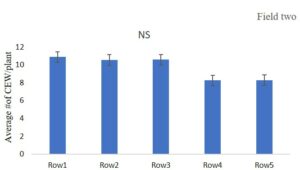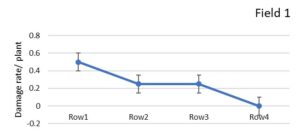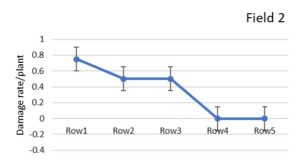Final report for FNE20-951
Project Information
Corn earworm (CEW), Helicoverpa zea, emerged as one of the key insect pests of hemp in Maryland. The project aims to develop a sustainable way of controlling CEW by using sweet corn as a trap crop. Moreover, in collaboration with Dr. Zebelo, we evaluated if heavy insect infestation increases the d9-Tetrahydrocannabinol (D9THC) beyond the legal limit (0.3%), several pieces of literature show insect damage changes plant chemistry. The number of Corn earworm larvae was counted weekly in hemp plant rows adjacent to the sweet corn trap crop plants, and their damage was recorded using visual inspection in two hemp fields. Moreover, the level of D9THC was measured in herbivore-damaged plants. The number of larvae recorded from the 1st row in field one and 1st, 2nd, and 3rd rows from field two showed a high number of insects over the six weeks of data collection. Similarly, the hemp plant damage rate decreases with the increase of the distance from the corn trap crop. Our results suggest that CBD hemp plants that were exposed to insect herbivory spikes in cannabinoid production and surpasseded the 0.3 % legal limit of D9THC. It was hypothesized that sweet corn might be a good trap for CEW. However, our research has shown that CEW actually prefers hemp to sweet corn. It seems hemp could be a candidate trap crop in other crop fields because we have seen several types of insect pests hanging around the hemp fields. The results of this study were shared with fellow growers at UMES small farm conference, UMES hemp conference, and around the Bay Small Farms club.
Objective 1: To develop a sustainable way of controlling CEW by using sweet corn as a trap crop
This project sought to develop a sustainable way of controlling CEW by using sweet corn as a trap crop. Attractive sweet corn will reduce the insect population in the main hemp crop fields. CEW reported as the main pest of hemp in the northeastern states (Britt et al 2019). This study might benefit hemp growers all over the nation.
Objective 2: To assess the impact of insect herbivore damage in the level of cannabinoids.
This objective sought to evaluate if the environmental factors such as insect damage increases the level of D9THC. The D9THC level for hemp (i.e. 0.3%) might be spiked up by insect herbivory, as a result farmers might lose legal coverage under 2018 Hemp Act. This objective provided info for educators, farmers and lawmakers.
Hemp and marijuana are both cannabis, but their morphology, chemical makeup, and usages are very different. Hemp has less than 0.3% of delta-9 tetrahydrocannabinol (D9THC) concentration. The recent Agriculture Improvement Act of 2018 includes language that further addressed many issues that had previously hampered the development of the crop. With the passage of the 2018 U. S. Farm Bill that removed hemp from the Federal list of controlled substances and declared it a distinct crop from marijuana, the emergence of hemp (Cannabis sativa) grown for CBD (cannabidiol) products as a potential crop has been sudden and dramatic. Hemp acreage expanded at a rapid pace in Maryland and other Northeastern states in 2019. However, due to the long moratorium on C. sativa in the United States, there is a serious lack of production knowledge for hemp and even less for pest management. Regarding available literature concerning insect pests present in North American hemp, information is dated, not region-specific, and does not address effective management methods.
Pest management in hemp is a serious source of concern and has proven to be challenging in Maryland this year. Because hemp production has been illegal for so long and with the complicated legality surrounding hemp, virtually no pest control products have been registered. Even if products were to be registered, labeling products for a new crop takes years. Consequently, Northeastern hemp growers have very few options for controlling the pests that are damaging their crops. Despite a lack of financial support for hemp-related research, Dr. Zebelo of UMES began research on hemp pest management in Maryland Eastern Shore. Russet mites (Aculops cannabicola) and corn earworm (Helicoverpa zea) have been the most important pests, such as brown marmorated stink bug (Halyomorpha halys), spotted cucumber beetle, and different types aphids have also been found in high densities on hemp. Despite that, the bill passed in 2014, and the recent Agriculture Improvement Act of 2018 includes language that further addressed many issues that had previously hampered the development of the crop. There is no EPA-labeled pesticide or bio-pesticide in the U.S. for industrial hemp, and growers are facing challenges to manage insect pests and diseases. Hemp producers indicate that target industrial hemp markets are sensitive to pesticide residue. Interestingly, the target market sensitivity to a pesticide will remain high even after EP-approved some pesticides because the method used to extract CBD oils will also even extract the trace amount of pesticide used, which may interfere with the quality of the CBD oil and final medicinal use.
Dr. Zebelo from UMES has identified most of the potential insect pests of hemp in our field. The most abundant and devastating pest was corn earworm (CEW). We had significant damage to the hemp flowers by CEW. CEW mainly dwelled and fed in between the flower buds, and it is difficult to see CEW until it causes visible damage Figure 1.
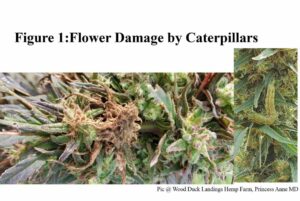
The CEW larvae contaminate the flowers with frass. Here, we are proposing to develop a sustainable way of controlling CEW by using sweet corn as a trap crop. Moreover, the project focuses on the 0.3% of D9THC in hemp plants that might be spiked as a result of various environmental stressors. One of the environmental stressors is insect herbivores. As noted above, hemp cannot contain more than 0.3 percent D9THC, per section 10113 of the Farm Bill 2018. Any cannabis plant that contains more than 0.3 percent D9THC would be considered non-hemp cannabis or marijuana under federal law and would thus face no legal protection under this new legislation.
Wood Duck Landing Farm is a 104-acre farm owned and operated by Michael and Kelly Edwards. Out of 104 acres, only 40 acres are tillable. I am a wounded warrior and started farming four years ago with my spouse Michael Edwards. I am a part-time farmer, but Michael is a full-time farmer. Our farm is equipped with two medium-size tractors, tomato/hemp planters, tractor-mounted mowers, mowers, two trailers, a farm shop (barn), a security system, two dedicated trucks, and raised bed maker. In about two-acre of our field, we mainly grow vegetables and fruits such as tomatoes, pepper, squash, watermelon, cucumber, blueberries…etc. Most of our products sold to farm stands, and restaurants. University of Maryland Eastern Shore (UMES) and University of Maryland College Park uses about an acre of our land for research. Our farm has participated in the 2018 hemp pilot program in collaboration with UMES, we have dedicated about 2 acres of our land for hemp. We have been working with Dr. Simon Zebelo of UMES last summer on cucurbit production. He has planted some flowers adjacent to watermelon and squash plots. Indeed we have observed several pollinator insects flying around the plots. This was interesting to see. We have understood that growing flowering plants near single-sexed crops increases yield significantly. Moreover, Dr. Zebelo has a USDA NIFA-funded project on the use of summer squash as a trap crop of cucumber beetles in watermelon plots. We have harvested squash and watermelon fruits several times, and it was the best summer since we started farming. We have attended several small farm conferences and training organized by universities and Chesapeake harvest. Dr. Zebelo's lab is equipped with cutting-edge instrumentation, and he assisted us with some analysis and experimental design.
Cooperators
Research
Objective 1: To develop a sustainable way of controlling CEW by using sweet corn as a trap crop
Background: When corn silk emergence was synchronized with tomato flowering and fresh corn silk was present during the tomato flowering stage, CEW infestation was lower in the tomato field with a corn border than in those without a corn border (Rhino et al., 2014), and attractive trap crops may further accentuate this tendency. Then, organically approved insecticides can be applied to the trap crop to arrest the CEW larvae.
Methods: Attractive trap crops, sweet corn plants were used to reduce corn earworm damage on hemp plots. Three line trap crop plants were planted along the borders (perimeter) of the hemp plot (10 inches in the row, with 36 inches between rows). Trap crop study plots were established on our farm at the beginning of the season (spring). Each test plot (hemp, Cherry blossom variety) was ~ 200 ft long x 200 ft wide (20 rows 10 ft apart, ~4-6 ft plant spacing) (Figure 2 ).
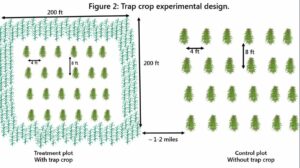
Similarly, the control plots were designed a mile or two miles apart from the trap crop plots. The hemp planting date was adjusted with sweet corn to match the sweet corn ear production stage with the flowering hemp stage. The population of CEW was monitored using Heliothis mesh traps baited with corn earworm pheromone. Weekly from July to September, the number of moths trapped was recorded to determine if adult trap catch correlates with worm/larval presence in the hemp fields. Ten plants were randomly selected per row and assessed for larvae per plant. Larval damage was visually evaluated, and the damage ratings were based on a scale of 1 to 4 (1: no damage; 2: low damage; 3: medium damage, and 4: high damage). Our farm topography suits our experimental design because our 40 acres of tillable land are distributed over our 104 acres of woodland, so we could replicate treatment (perimeter crop) and controls at least three times.
Objective 2: To assess the impact of insect herbivore damage on the level of cannabinoids
Background: state and federal law dictated that Taylor do away with the crop. Any hemp plant with more than 0.3 percent D9THC, the psychoactive component, is considered marijuana, not hemp, and is therefore illegal without the licenses required to grow medical or recreational marijuana. The percentage may seem arbitrary. Here we tested how the D9THC and other cannabinoids might vary with insect herbivory.
Methods:
Feminized Hemp varieties, Cherry Blossom, and The Wife seeds were purchased from FortunaHemp. The seeds were sown in sterilized potting soil (ProMIX BXM) and placed in growth chambers until the plants reached the mature flowering stage. The growth chambers were set at 12 hrs photoperiod for the first six weeks and eight hours of photoperiod for three weeks at 27/25oC (Day/Night) temperature. At approximately ten weeks old female plants were used for insect herbivory tests in the laboratory experiment. The hemp plants were housed in 61 x 61 x 61 cm3 bugdorme cages and acclimated overnight before the experiment started. The plants from each variety were subjected to herbivore damage (HD), Mechanical damage (MD), and Control. Twenty-five pre-starved fourth instar larvae were introduced to each hemp flower and leave near them in a cage to inflect herbivore damage for 24 hrs. Plants were clamped with paper clamber to inflect mechanical damage. And the Control plants were kept in a cage with no HD and MD. After 24 hours, 10-12 cm flower inflorescences with some leaves were collected from HD, MD, and Control plants for cannabinoid extraction. Each treatment was replicated at least three times using the two hemp varieties. The cannabinoids were extracted by drying the flowers at 40oC with forced air ventilation for two hours and pulverized to through in a 1 mm sieve. One hundred milligrams of the ground samples were dissolved in 30ml of isopropanol and sonicated for 30 minutes. The samples were centrifuged at 6000 rpm for 3 minutes, and the supernatant was recovered in a glass vial. Finally, 1ml of the samples were decarboxylated (convert THCA to D9THC/ CBDA to CBD) by evaporating to dryness at 80 °C for 20 minutes. The samples are reconstituted in 500µl of isopropanol and analyzed by Gas Chromatography- Flame Ion Detector (GC-FID) following the Drug Enforcement Administration (DEA) protocols. Hemp produced in conjunction with the SARE grant was destroyed.
As per the proposal, attractive trap crops, sweet corn, were used to reduce corn earworm damage on hemp plots. Four lines of trap crop were planted along the borders (perimeter) of the Mountain Mango hemp variety plot (10 inches in the row, with 36 inches between rows). Similarly, the control plot was designed a mile apart from the trap crop plots. Attempts were made to adjust the hemp planting date with sweet corn to match the sweet corn ear production stage with hemp’s flowering stage. Unfortunately, this experiment was progressing well, and then just about the time when the hemp was about to flower in August. Unfortunately, we were struck by tropical storm Isaias. The sweet corn plants were swept completely, and they could not recover Figure 3.
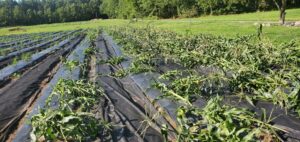
In summer 2021, we repeated the field experiment with modifications to the methodology. In 2021 hemp seedlings were transplanted in rows at a distance of(12ft, 24ft, 36ft, 48ft, and 60ft) from the border corn plants, and larvae were counted every week for 6 consecutive weeks from four randomly selected hemp plants from each row, and this was replicated two times. Plant damage recorded using visual scale from 0 to 3 where 0= no damage; 1 = very minimal damage; 2 = damage to 50%; 3 =damage more than 50%.
Interestingly, the number of larvae in hemp plants decreases as the distance from the trap crop increases. The number of larvae recorded from the 1st row in field one and 1st 2nd and 3rd rows from field two showed a high number of insects over the six weeks of data collection Figure 4 and Figure 5. Similarly, the hemp plant damage rate decreases with the increase of the distance from the corn trap crop Figure 6 and Figure 7. In a related study, In Dr. Zebelo's lab evaluated the oviposition preference of corn CEW between hemp and corn plants in a two-choice experiment under laboratory conditions. CEW preferred to lay more eggs on hemp plants than sweet corn plants.
Fig 4
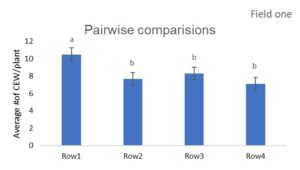
On our farm, we hosted a Farm club meeting in August that was attended by around 20 farmers, one of the farmers mentioned that her edible amaranths grown next to hemp plants had less damage than the amaranths grown on the other side of her plot. Moreover, our farm trial was part of the University of Maryland Eastern Shore small farm conference, and around 30-40 people visited the research trial on our farm.
In the United States, industrial hemp is defined as a Cannabis sativa L. plant not containing more than 0.3% delta-9-tetrahydrocannabinol (D9THC) by dry weight. Plants respond to insect herbivore damage by changing their chemistry to counter the effects of herbivore attacks. Here, we hypothesized that the corn earworm (Helicoverpa zea) infestation might impact the level of cannabinoids (Cannabidiol (CBD) and D9THC).
In a field trial, the CBD hemp, Cherry Blossom, and The Wife varieties were subjected to herbivore damage (HD), Mechanical damage (MD), and Control. After 24hrs of the treatments, we found a significant increase in CBD and D9THC in HD plants compared with MD and Control plants Figure 8.
Fig 8
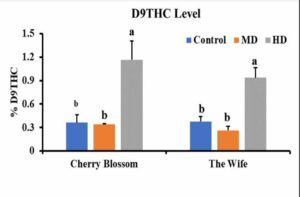
Similar experiments were conducted in the field condition in the wood duck landing farm. A substantial increase in CBD and D9THC was observed in herbivore damaged hemp plants compared to the control plants. However, in the field trial, the levels of cannabinoids were not significantly higher in The wife variety. Interestingly, the Corn earworm larvae fed with CBD and D9THC spiked diet showed a significant reduction in body mass than the larvae fed with the control diets.
The level of cannabinoids seems not genetically fixed somewhat; it is affected by insect herbivory. Our results suggest that CBD hemp plants are exposed to insect herbivory spikes in cannabinoid production and surpass the 0.3 % legal limit of D9THC. The growth and development of Corn earworm, the number one hemp pest in North America affected by cannabinoids. The increased concentration of CBD and D9THC observed in herbivore-damaged hemp plants might be associated with the direct deterrence of the corn earworm larvae. Further research is underway using different hemp varieties to assess if herbivory and other biotic stressors impact the level of cannabinoids.
It was hypothesized that sweet corn might be a good trap of CEW. However, our research has shown that CEW actually prefers hemp to sweet corn.
It seems hemp could be a candidate trap crop in other crop fields because we have seen several types of insect pests hanging around the hemp fields.
Education & Outreach Activities and Participation Summary
Participation Summary:
Our farm and project were featured in a presentation at the UMES Hemp Conference, the UMES Small Farms Conference, and during the UMES Around the Bay Small Farms club. At the UMES Hemp Conference Simon Zebello and Michael Edwards did a powerpoint presentation on the project. In Aug we hosted 20 farmers for a tour of our farm where we talked about the project. At the UMES Small Farms conference, we had a farm tour and showed the participants our project and the outcomes.
Learning Outcomes
Project Outcomes
While the project proved our hypothesis wrong, we did learn a lot about corn earworms and the use of capture crops. Also because of our project we had a lot of exposure to our farm that wouldn't have otherwise happened with two farm tours sponsored by UMES.
Our study proved our hypothesis wrong. We found that corn earworm preferred hemp to sweet corn. So we could use hemp as a capture crop for sweet corn, but unfortunately, legislation has practically killed the hemp industry (for CBD production) in Maryland. Unless laws change or new varieties are invented that can meet the impossible standard for THC in hemp plants, I don't believe there will be many growers of hemp in Maryland.
During one of the farm tours, one of the farmers mentioned that her edible amaranths grown next to hemp plants had less damage than the amaranths grown on the other side of her plot. Further study would be needed to show that hemp could act as a capture crop.
Information Products
- Managing Corn Earworm in Hemp Field by Using Sweet Corn as a Trap Crop (Conference/Presentation Material)
